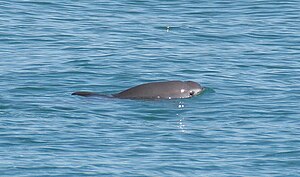Vaquita - Phocoena sinus: Difference between revisions
WikiAnimal (talk | contribs) No edit summary |
No edit summary |
||
| Line 35: | Line 35: | ||
== References == | == References == | ||
<references /> | <references /> | ||
[[Category:Cetacean]] | [[Category:Cetacean]] | ||
[[Category:Phocoenidae (family)]] | |||
Revision as of 12:06, 11 July 2023

The vaquita (Phocoena sinus) is a rare and endangered species of porpoise that lives only in a small area of the Gulf of California, Mexico. It is the smallest and most threatened cetacean in the world, with an estimated 10 individuals remaining in the wild.[1] The main cause of their decline is bycatch in illegal fishing nets set for another endangered fish, the totoaba, whose swim bladder is highly valued in China.
A vaquita is a type of porpoise, which is a group of small toothed whales that are closely related to dolphins. The word "vaquita" means "little cow" in Spanish, and it refers to the dark rings around their eyes and mouth that resemble a cow's markings. Vaquitas have a gray body with a white belly, a triangular dorsal fin, and no distinct beak. They can grow up to 5 feet long and weigh up to 120 pounds, making them the smallest of all cetaceans.
Vaquitas are shy and elusive animals that are rarely seen by humans. They usually swim alone or in pairs, and sometimes form small groups of up to 10 individuals. They feed on small fish, squid, and crustaceans that live near the bottom of the sea. They can dive up to 300 feet deep and hold their breath for up to 10 minutes. They communicate with each other using high-pitched clicks and whistles that are beyond the range of human hearing.
Vaquitas live only in a small area of the northern Gulf of California, also known as the Sea of Cortez, between Baja California and mainland Mexico. This area is rich in biodiversity and supports many other marine species, such as whales, dolphins, sea lions, sea turtles, sharks, rays, and corals. The vaquita's habitat is characterized by shallow waters, strong currents, high salinity, and variable temperature.
Vaquitas prefer to stay close to shore, within 30 miles of the coast, and in water depths of less than 150 feet. They are most often found near two islands: Isla Cerralvo and Isla San Lorenzo. They have a very limited range of about 1,500 square miles, which makes them vulnerable to human activities and environmental changes.
Vaquitas are critically endangered, meaning they face an extremely high risk of extinction in the wild. According to the latest population estimate from 2019, there are only about 10 vaquitas left in the world. This represents a dramatic decline from about 600 vaquitas in 1997, when they were first recognized as endangered.
The main threat to vaquitas is bycatch, which means they get accidentally caught and drowned in fishing nets that are not intended for them. The most dangerous nets are gillnets, which are large walls of mesh that hang vertically in the water and trap any animal that swims into them. Gillnets are used by illegal fishermen who target another endangered fish called the totoaba, which has a large swim bladder that can fetch thousands of dollars per kilogram in China for its supposed medicinal properties.
The illegal trade of totoaba swim bladders has created a lucrative black market. Despite efforts by the Mexican government and international organizations to ban gillnets and enforce laws against poaching and smuggling, the demand for totoaba remains high and the enforcement is weak. As a result, vaquitas continue to die in gillnets at an alarming rate.
Other threats to vaquitas include habitat degradation due to pollution, overfishing, climate change, and reduced freshwater inflow from rivers. These factors may affect the availability and quality of food and water for vaquitas and their prey.
See also
External links
Articles
- 11 Facts About the Vaquita, The World's Most Endangered Porpoise Mental Floss
- This is the stunning vaquita, the rarest animal in the world. Only 10 of them exist. Upworthy.com
Video
- Vaquita - The Business of Extinction CNN documentary video
- 2023 Vaquita Survey Press Conference Sea Shepherd Conservation Society
References
- ↑ How many Vaquitas are left in the world in 2023? Porpoise Conservation Society
